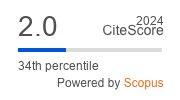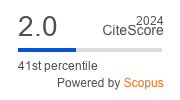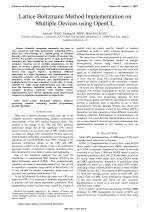| 3/2018 - 1 | View TOC | « Previous Article | Next Article » |
Lattice Boltzmann Method Implementation on Multiple Devices using OpenCLTEKIC, J. B. |
| Extra paper information in |
| Click to see author's profile in |
| Download PDF |
Author keywords
Lattice Boltzmann methods, multicore processing, scientific computing, parallel programming, parallel algorithms
References keywords
lattice(21), boltzmann(21), method(11), multi(8), simulations(6), flow(6), flows(5), computational(5), time(4), relaxation(4)
Blue keywords are present in both the references section and the paper title.
About this article
Date of Publication: 2018-08-31
Volume 18, Issue 3, Year 2018, On page(s): 3 - 8
ISSN: 1582-7445, e-ISSN: 1844-7600
Digital Object Identifier: 10.4316/AECE.2018.03001
Web of Science Accession Number: 000442420900001
SCOPUS ID: 85052088705
Abstract
Scientific computing community has been in close connection with high performance computing (HPC), which has been privilege of a limited group of scientists. Recently, with rapid development of Graphics Processing Units (GPUs), the parallel processing power of high performance computers has been brought up to every commodity desktop computer, reducing cost of scientific computations. In this paper, we develop a general purpose Lattice Boltzmann code that runs on commodity computer with multiple heterogeneous devices that support OpenCL specification. Different approaches to Lattice Boltzmann code implementations on commodity computer with multiple devices were explored. Simulation results for different code implementations on multiple devices have been compared to each other, to results obtained for single device implementation and with results from the literature. Simulation results for the commodity computer hardware platforms with multiple devices implementation have showed significant speed improvement compared to simulation implemented on single device. |
| References | | | Cited By «-- Click to see who has cited this paper |
| [1] W. Shi, W. Shyy, R. Mei, "Finite-difference-based lattice Boltzmann method for inviscid compressible flows," Numerical Heat Transfer, Part B: Fundamentals, vol. 40, no. 1, pp. 1-21, 2001. [CrossRef] [Web of Science Times Cited 64] [SCOPUS Times Cited 65] [2] R. Mei, W. Shyy, D. Yu, L.-S. Luo, "Lattice Boltzmann Method for 3-D Flows with Curved Boundary," Journal of Computational Physics, vol. 161, no. 2, pp. 680-699, 2000. [CrossRef] [Web of Science Times Cited 280] [SCOPUS Times Cited 321] [3] Z. Guo, T. S. Zhao, "A lattice Boltzmann model for convective heat transfer in porous media," Numerical Heat Transfer, Part B: Fundamentals, vol. 47, no. 2, pp. 157-177, 2005. [CrossRef] [Web of Science Times Cited 262] [SCOPUS Times Cited 297] [4] P. M. Tekic, J. B. RaÄenovic, N. Lukic, S. S. Popovic, "Lattice Boltzmann simulation of two-sided lid-driven flow in a staggered cavity," International Journal of Computational Fluid Dynamics, vol. 24, no. 9, pp. 383-390, 2010. [CrossRef] [Web of Science Times Cited 11] [SCOPUS Times Cited 17] [5] O. Filippova, D. Hanel, "A Novel Lattice BGK Approach for Low Mach Number Combustion," Journal of Computational Physics, vol. 158, no. 2, pp. 139-160, 2000. [CrossRef] [Web of Science Times Cited 132] [SCOPUS Times Cited 141] [6] K. Mattila, J. Hyvaluoma, J. Timonen, T. Rossi, "Comparison of implementations of the lattice-Boltzmann method," Computers & Mathematics with Applications, vol. 55, no. 7, pp. 1514-1524, 2008. [CrossRef] [Web of Science Times Cited 49] [SCOPUS Times Cited 65] [7] S. Tomov, M. McGuigan, R. Bennett, G. Smith, J. Spiletic, "Benchmarking and implementation of probability-based simulations on programmable graphics cards," Computers & Graphics, vol. 29, no. 1, pp. 71-80, 2005. [CrossRef] [Web of Science Times Cited 32] [SCOPUS Times Cited 46] [8] W. Li, X. Wei, A. Kaufman,"Implementing lattice Boltzmann computation on graphics hardware," The Visual Computer, vol. 19, no. 8, pp. 444-456, 2003. [CrossRef] [Web of Science Times Cited 112] [SCOPUS Times Cited 153] [9] D. Vidal, R. Roy, F. Bertrand, "A parallel workload balanced and memory efficient lattice-Boltzmann algorithm with single unit BGK relaxation time for laminar Newtonian flows," Computers & Fluids, vol. 39, no. 8, pp. 1411-1423, 2010. [CrossRef] [10] J. A. Anderson, C. D. Lorenz, A. Travesset, "General purpose molecular dynamics simulations fully implemented on graphics processing units," Journal of Computational Physics, vol. 227, no. 10, pp. 5342-5359, 2008. [CrossRef] [Web of Science Times Cited 1195] [SCOPUS Times Cited 1283] [11] K. Chen, C. Lin, S. Zhong, L. Guo, "A Parallel SRM Feature Extraction Algorithm for Steganalysis Based on GPU Architecture," Computer Science and Information Systems, vol. 12, no. 4, pp. 1345-1359, 2015. [CrossRef] [Web of Science Times Cited 3] [SCOPUS Times Cited 2] [12] P. M. Tekic, J. B. Radjenovic, M. Rackovic, "Implementation of the Lattice Boltzmann Method on Heterogeneous Hardware and Platforms using OpenCL," Advances in Electrical and Computer Engineering, vol. 12, no. 1, pp. 51-56, 2012. [CrossRef] [Full Text] [Web of Science Times Cited 5] [SCOPUS Times Cited 6] [13] C. Obrecht, F. Kuznik, B. Tourancheau, J.-J. Roux, "Multi-GPU implementation of the lattice Boltzmann method," Computers & Mathematics with Applications, vol. 65, no. 2, pp. 252-261, 2013. [CrossRef] [Web of Science Times Cited 94] [SCOPUS Times Cited 111] [14] H.-W. Chang, P.-Y. Hong, L.-S. Lin, C.-A. Lin, "Simulations of Three-dimensional Cavity Flows with Multi Relaxation Time Lattice Boltzmann Method and Graphic Processing Units," Procedia Engineering, vol. 61, pp. 94-99, 2013. [CrossRef] [SCOPUS Times Cited 5] [15] H.-W. Chang, P.-Y. Hong, L.-S. Lin, C.-A. Lin, "Simulations of flow instability in three dimensional deep cavities with multi relaxation time lattice Boltzmann method on graphic processing units," Computers & Fluids, vol. 88, pp. 866-871, 2013. [CrossRef] [Web of Science Times Cited 21] [SCOPUS Times Cited 23] [16] C. Huang, B. Shi, N. He, Z. Chai, "Implementation of Multi-GPU Based Lattice Boltzmann Method for Flow Through Porous Media," Advances in Applied Mathematics and Mechanics, vol. 7, no. 1, pp. 1-12, 2015. [CrossRef] [Web of Science Times Cited 38] [SCOPUS Times Cited 29] [17] P.-Y. Hong, L.-M. Huang, L.-S. Lin, C.-A. Lin, "Scalable multi-relaxation-time lattice Boltzmann simulations on multi-GPU cluster," Computers & Fluids, vol. 110, pp. 1-8, 2015. [CrossRef] [Web of Science Times Cited 36] [SCOPUS Times Cited 38] [18] W. Xian, A. Takayuki, "Multi-GPU performance of incompressible flow computation by lattice Boltzmann method on GPU cluster," Parallel Computing, vol. 37, no. 9, pp. 521-535, 2011. [CrossRef] [Web of Science Times Cited 130] [SCOPUS Times Cited 163] [19] B. Massimo, F. Massimiliano, M. Simone, S. Sauro, K. Efthimios, "A flexible high-performance Lattice Boltzmann GPU code for the simulations of fluid flows in complex geometries,"Concurrency and Computation: Practice and Experience, vol. 22, no. 1, pp. 1-14, 2010. [CrossRef] [20] E. Calore, S. F. Schifano, R. Tripiccione, "A Portable OpenCL Lattice Boltzmann Code for Multi- and Many-core Processor Architectures," Procedia Computer Science, vol. 29, pp. 40-49, 2014. [CrossRef] [Web of Science Times Cited 12] [SCOPUS Times Cited 13] [21] P. L. Bhatnagar, E. P. Gross, M. Krook, "A Model for Collision Processes in Gases. I. Small Amplitude Processes in Charged and Neutral One-Component Systems," Physical Review, vol. 94, no. 3, pp. 511-525, 1954. [CrossRef] [SCOPUS Times Cited 7332] [22] X. He, L. Luo, "Theory of the lattice Boltzmann method: From the Boltzmann equation to the lattice Boltzmann equation," Physical Review, vol. 56, no. 6, pp. 6811-6817, 1997. [CrossRef] [Web of Science Times Cited 1386] [SCOPUS Times Cited 1582] [23] D. V. Patil, K. N. Lakshmisha, B. Rogg, "Lattice Boltzmann simulation of lid-driven flow in deep cavities," Computers & Fluids, vol. 35, no. 10, pp. 1116-1125, 2006. [CrossRef] [Web of Science Times Cited 72] [SCOPUS Times Cited 84] [24] S. Hou, Q. Zou,S. Chen, G. Doolen, A. C. Cogley, "Simulation of Cavity Flow by the Lattice Boltzmann Method," Journal of Computational Physics, vol. 118, no. 2, pp. 329-347, 1995. [CrossRef] [Web of Science Times Cited 548] [SCOPUS Times Cited 647] Web of Science® Citations for all references: 4,482 TCR SCOPUS® Citations for all references: 12,423 TCR Web of Science® Average Citations per reference: 179 ACR SCOPUS® Average Citations per reference: 497 ACR TCR = Total Citations for References / ACR = Average Citations per Reference We introduced in 2010 - for the first time in scientific publishing, the term "References Weight", as a quantitative indication of the quality ... Read more Citations for references updated on 2025-06-03 22:53 in 168 seconds. Note1: Web of Science® is a registered trademark of Clarivate Analytics. Note2: SCOPUS® is a registered trademark of Elsevier B.V. Disclaimer: All queries to the respective databases were made by using the DOI record of every reference (where available). Due to technical problems beyond our control, the information is not always accurate. Please use the CrossRef link to visit the respective publisher site. |
Faculty of Electrical Engineering and Computer Science
Stefan cel Mare University of Suceava, Romania
All rights reserved: Advances in Electrical and Computer Engineering is a registered trademark of the Stefan cel Mare University of Suceava. No part of this publication may be reproduced, stored in a retrieval system, photocopied, recorded or archived, without the written permission from the Editor. When authors submit their papers for publication, they agree that the copyright for their article be transferred to the Faculty of Electrical Engineering and Computer Science, Stefan cel Mare University of Suceava, Romania, if and only if the articles are accepted for publication. The copyright covers the exclusive rights to reproduce and distribute the article, including reprints and translations.
Permission for other use: The copyright owner's consent does not extend to copying for general distribution, for promotion, for creating new works, or for resale. Specific written permission must be obtained from the Editor for such copying. Direct linking to files hosted on this website is strictly prohibited.
Disclaimer: Whilst every effort is made by the publishers and editorial board to see that no inaccurate or misleading data, opinions or statements appear in this journal, they wish to make it clear that all information and opinions formulated in the articles, as well as linguistic accuracy, are the sole responsibility of the author.



